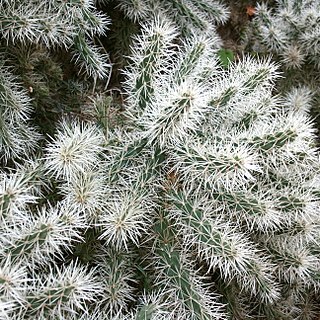Low spreading, dense, many-branched shrub 0.3–0.5 (–0.7) m high, to 3 m diam., large plants producing a trunk to 60 cm high. Stem segments whorled or subwhorled, cylindric, (5–) 10–20 (–25) cm long, 15–30 mm diam., prominently tuberculate, glabrous, grey-green, terminal segments readily detached; tubercles broadly oval, prominent, 10–20 (–30) mm long, 3.5–6 mm wide, projecting 7–10.5 mm, rib-like, laterally compressed. Areoles apical on tubercles, oblong to obovate, 3–5 mm long, typically 15–25 mm apart mm apart, sunken, filled with white to pale dirty yellow wool, and glochids. Leaves succulent, terete, tapering to apex, 2–2.5 mm long. Spines 4–10 per areole, spreading, the longer spines 15–38 mm long, 0.6–1.1 mm wide near base, with 1–3 smaller spines, reddish brown, brown to pale yellowish brown, apex pale yellow; spine sheaths loosely fitting, pale yellowish to tan or occasionally white. Glochids in a dense adaxial tuft, 1.4–2 mm long, light to dark brown. Flowers 25–30 mm diam.; outer tepals reduced, fleshy, greenish with margins, or tinged red, cubeate-oblong or broadly cuneate, 3–12 mm long, 6–9(–12) mm wide; inner tepals yellow, yellowish green to yellowish fawn, obovate to spathulate, 12–20 mm long, 9–12 mm wide, the apex obtuse, with a short mucro. Staminal filaments white, anthers pale yellow. Style thick, white or pale cream; stigma lobes pale yellow or pale greenish yellow. Pericarpel tuberculate, spineless. Fruit solitary, broadly ovoid to subglobose, 20–35 mm long, 15–25 mm diam., the umbilicus deep, weakly tuberculate, spineless, succulent, yellow to yellowish green at maturity and often suffused with red, splitting vertically on one side when ripe. Seeds subglobose to angular, 3.2–3.5 mm long, 2.7–3.3 mm wide.
More
Shrubs, densely branched, 0.3-0.6 m. Stem segments easily detached, whorled or subwhorled, pale green to green, 5-20(-25) × 1.5-2.5 cm; tubercles very prominent, broad, 2-3 cm; areoles obdeltate, 4.5-8 × 2.5-5 mm; wool yellow-tan, aging gray. Spines 5-12 per areole, at most areoles, spreading, obscuring stems, yellow, acicular, larger ones 3-6 cm; sheaths persisting, yellow to tan, loosely fitting, 2-4 mm diam. Glochids in small adaxial tuft, pale yellow, 0.5-1.2 mm. Flowers: inner tepals yellow to yellow-green, spatulate, 15-20 mm, apiculate; filaments yellowish; anthers yellow; style green to reddish; stigma lobes yellow-green to green. Fruits usually sterile, not proliferating, yellow to yellow-green, often tinged red, top-shaped to clavate, 25-50 × 8-15 mm, pulpy, tuberculate, spineless or sometimes weakly spined; tubercles subequal; umbilicus 5-7 mm deep; areoles 32-40. Seeds light tan, ± obovate, to 2.5 × 2 mm; girdle smooth. 2n = 22.
In Australia, Cylindropuntia tunicata is predominantly naturalised in the subarid and arid inland regions, often an environmental weed. In Western Australia it is known only from around Coolgardie where growing on vacant land, and in mallee. In South Australia it has been collected from flats above a creek in Eucalyptus largiflorens woodland on compacted brown loams, where growing with Atriplex lindleyi, Enchylaena tomentosa, Sclerolaena sp. and Mesembryanthemum nodiflorum. In Queensland it has been collected from woodland dominated by Acacia harpophylla, A. salicina, Geijera parviflora and Lysiphyllum, on heavy clay soil. In New South Wales, it is found in the North Western Plains area, around the Grawin opal fields, where naturalised in Eucalyptus populnea subsp. bimbil woodland, on red sand. In Victoria it is grows in mixed mallee woodland, with chenopod understorey.
More
Xerophyllous shrubland, Chihuahuan Desert, sandy to gravelly substrates, usually calcareous slopes or alluvium; at elevations from 100-1,900 metres.


